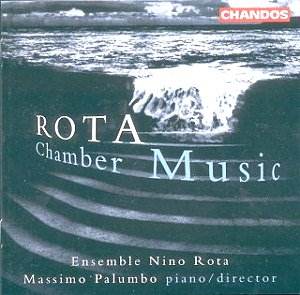Nino ROTA
Chamber Music
Trio for clarinet, cello and piano (1973), Sonata for Viola and Piano
(1935), Trio for flute, violin and piano (1958), Sonata for Violin and Piano
(1937)
 Ensemble Nino Rota
Ensemble Nino Rota
 Chandos CHAN 9832
[62:56]
Chandos CHAN 9832
[62:56]
Crotchet
Amazon
UK
Amazon
USA

Following the excellent disc of chamber music by Nino Rota on ASV CD
DCA 1072 (see
my
review on CMOTW), it is a pleasure to welcome this programme from Chandos.
There are six works on the ASV programme, of which the two trios reappear
in versions here. There is little purpose in my repeating my general comments
on the music itself, suffice to say that the opening trio benefits from a
relaxed, limpid, utterly fluid approach which really allows the elegant structure
of Rota's writing to shine. This version by the Ensemble Nino Rota lacks
the urgent attack of the Ex Novo Ensemble on ASV, and while it may be a matter
of taste, seems to better capture the essential beauty at the heart of the
composer's work. The tone is smoother, more melodic, the musicianship more
graceful. The same can be said of the Trio for flute, violin and piano
from 1958, a more skittish, disturbed work which likewise benefits from a
greater clarity.
The two sonatas date from early in Rota's career, when he was very influenced
by the music of the Renaissance. Even so, they appear as late-Romantic works
stripped down to a pastoral heart, shorn of overwrought emotionalism.
Anti-neurotic, indeed almost anti-20th Century in their civilised
elegance, Rota's compositions happily reflect a personality who wrote music
to appeal to the listener rather than the theoretician.
This is a more tranquil programme than that by the Ex Novo Ensemble, the
recently formed Ensemble Nino Rota delivering a beguiling concert. The result
is an album to be treasured, and while I am very glad to have both this and
the ASV in my collection it is hard, given the overlap of material, to recommend
that any other than the more dedicated follower of the composer acquire both.
My solution would be to chose the ASV album for greater vitality and diversity
of material, the Chandos for sheer beauty and exquisite musicianship.
Gary S. Dalkin

